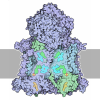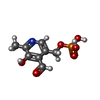[English] 日本語
 Yorodumi
Yorodumi- PDB-3ppl: Crystal structure of an aspartate transaminase (NCgl0237, Cgl0240... -
+ Open data
Open data
- Basic information
Basic information
| Entry | Database: PDB / ID: 3ppl | ||||||
|---|---|---|---|---|---|---|---|
| Title | Crystal structure of an aspartate transaminase (NCgl0237, Cgl0240) from CORYNEBACTERIUM GLUTAMICUM ATCC 13032 KITASATO at 1.25 A resolution | ||||||
 Components Components | ASPARTATE AMINOTRANSFERASE | ||||||
 Keywords Keywords | TRANSFERASE / AMINOTRANSFERASE / DIMER / PLP-DEPENDENT TRANSFERASE-LIKE FOLD / STRUCTURAL GENOMICS / JOINT CENTER FOR STRUCTURAL GENOMICS / JCSG / PROTEIN STRUCTURE INITIATIVE / PSI-BIOLOGY | ||||||
| Function / homology |  Function and homology information Function and homology informationaspartate transaminase / L-aspartate:2-oxoglutarate aminotransferase activity Similarity search - Function | ||||||
| Biological species |  Corynebacterium glutamicum (bacteria) Corynebacterium glutamicum (bacteria) | ||||||
| Method |  X-RAY DIFFRACTION / X-RAY DIFFRACTION /  SYNCHROTRON / SYNCHROTRON /  MAD / Resolution: 1.25 Å MAD / Resolution: 1.25 Å | ||||||
 Authors Authors | Joint Center for Structural Genomics (JCSG) | ||||||
 Citation Citation |  Journal: To be published Journal: To be publishedTitle: Crystal structure of an aspartate transaminase (NCgl0237, Cgl0240) from CORYNEBACTERIUM GLUTAMICUM ATCC 13032 KITASATO at 1.25 A resolution Authors: Joint Center for Structural Genomics (JCSG) | ||||||
| History |
|
- Structure visualization
Structure visualization
| Structure viewer | Molecule:  Molmil Molmil Jmol/JSmol Jmol/JSmol |
|---|
- Downloads & links
Downloads & links
- Download
Download
| PDBx/mmCIF format |  3ppl.cif.gz 3ppl.cif.gz | 403.3 KB | Display |  PDBx/mmCIF format PDBx/mmCIF format |
|---|---|---|---|---|
| PDB format |  pdb3ppl.ent.gz pdb3ppl.ent.gz | 335.5 KB | Display |  PDB format PDB format |
| PDBx/mmJSON format |  3ppl.json.gz 3ppl.json.gz | Tree view |  PDBx/mmJSON format PDBx/mmJSON format | |
| Others |  Other downloads Other downloads |
-Validation report
| Arichive directory |  https://data.pdbj.org/pub/pdb/validation_reports/pp/3ppl https://data.pdbj.org/pub/pdb/validation_reports/pp/3ppl ftp://data.pdbj.org/pub/pdb/validation_reports/pp/3ppl ftp://data.pdbj.org/pub/pdb/validation_reports/pp/3ppl | HTTPS FTP |
|---|
-Related structure data
| Similar structure data | |
|---|---|
| Other databases |
- Links
Links
- Assembly
Assembly
| Deposited unit | 
| ||||||||
|---|---|---|---|---|---|---|---|---|---|
| 1 |
| ||||||||
| Unit cell |
| ||||||||
| Details | ANALYTICAL SIZE EXCLUSION CHROMATOGRAPHY WITH STATIC LIGHT SCATTERING SUPPORTS THE ASSIGNMENT OF A DIMER AS A SIGNIFICANT OLIGOMERIZATION STATE IN SOLUTION. |
- Components
Components
| #1: Protein | Mass: 47044.512 Da / Num. of mol.: 2 Source method: isolated from a genetically manipulated source Source: (gene. exp.)  Corynebacterium glutamicum (bacteria) / Strain: ATCC 13032 KITASATO / Gene: aspB, cg0294 / Plasmid: SpeedET / Production host: Corynebacterium glutamicum (bacteria) / Strain: ATCC 13032 KITASATO / Gene: aspB, cg0294 / Plasmid: SpeedET / Production host:  References: UniProt: Q6M8B5, UniProt: Q8NTR2*PLUS, aspartate transaminase #2: Chemical | #3: Chemical | Num. of mol.: 2 / Source method: obtained synthetically #4: Chemical | #5: Water | ChemComp-HOH / | Sequence details | THIS CONSTRUCT WAS EXPRESSED WITH A PURIFICATION TAG MGSDKIHHHHHHENLYFQG. THE TAG WAS REMOVED WITH ...THIS CONSTRUCT WAS EXPRESSED WITH A PURIFICATI | |
|---|
-Experimental details
-Experiment
| Experiment | Method:  X-RAY DIFFRACTION / Number of used crystals: 1 X-RAY DIFFRACTION / Number of used crystals: 1 |
|---|
- Sample preparation
Sample preparation
| Crystal | Density Matthews: 2.44 Å3/Da / Density % sol: 49.63 % |
|---|---|
| Crystal grow | Temperature: 293 K / Method: vapor diffusion, sitting drop / pH: 4.2 Details: 0.2M sodium chloride, 20.0% polyethylene glycol 8000, 0.1M phosphate-citrate pH 4.2, Additive: 0.001 M alpha-ketoglutaric acid, NANODROP', VAPOR DIFFUSION, SITTING DROP, temperature 293K |
-Data collection
| Diffraction | Mean temperature: 100 K | |||||||||||||||||||||||||||||||||||||||||||||||||||||||||||||||||||||||||||||
|---|---|---|---|---|---|---|---|---|---|---|---|---|---|---|---|---|---|---|---|---|---|---|---|---|---|---|---|---|---|---|---|---|---|---|---|---|---|---|---|---|---|---|---|---|---|---|---|---|---|---|---|---|---|---|---|---|---|---|---|---|---|---|---|---|---|---|---|---|---|---|---|---|---|---|---|---|---|---|
| Diffraction source | Source:  SYNCHROTRON / Site: SYNCHROTRON / Site:  SSRL SSRL  / Beamline: BL11-1 / Wavelength: 0.91837,0.97944,0.97908 / Beamline: BL11-1 / Wavelength: 0.91837,0.97944,0.97908 | |||||||||||||||||||||||||||||||||||||||||||||||||||||||||||||||||||||||||||||
| Detector | Type: MARMOSAIC 325 mm CCD / Detector: CCD / Date: Feb 11, 2010 | |||||||||||||||||||||||||||||||||||||||||||||||||||||||||||||||||||||||||||||
| Radiation | Monochromator: SINGLE CRYSTAL SI(111) BENT / Protocol: MAD / Monochromatic (M) / Laue (L): M / Scattering type: x-ray | |||||||||||||||||||||||||||||||||||||||||||||||||||||||||||||||||||||||||||||
| Radiation wavelength |
| |||||||||||||||||||||||||||||||||||||||||||||||||||||||||||||||||||||||||||||
| Reflection | Resolution: 1.25→29.324 Å / Num. obs: 241991 / % possible obs: 92.1 % / Observed criterion σ(I): -3 / Redundancy: 3.6 % / Biso Wilson estimate: 10.292 Å2 / Rmerge(I) obs: 0.035 / Net I/σ(I): 13.04 | |||||||||||||||||||||||||||||||||||||||||||||||||||||||||||||||||||||||||||||
| Reflection shell | Diffraction-ID: 1
|
-Phasing
| Phasing | Method:  MAD MAD |
|---|
- Processing
Processing
| Software |
| ||||||||||||||||||||||||||||||||||||||||||||||||||||||||||||||||||||||||||||||||||||||||||||||||||||
|---|---|---|---|---|---|---|---|---|---|---|---|---|---|---|---|---|---|---|---|---|---|---|---|---|---|---|---|---|---|---|---|---|---|---|---|---|---|---|---|---|---|---|---|---|---|---|---|---|---|---|---|---|---|---|---|---|---|---|---|---|---|---|---|---|---|---|---|---|---|---|---|---|---|---|---|---|---|---|---|---|---|---|---|---|---|---|---|---|---|---|---|---|---|---|---|---|---|---|---|---|---|
| Refinement | Method to determine structure:  MAD / Resolution: 1.25→29.324 Å / Cor.coef. Fo:Fc: 0.985 / Cor.coef. Fo:Fc free: 0.981 / Occupancy max: 1 / Occupancy min: 0.23 / SU B: 0.86 / SU ML: 0.017 / Cross valid method: THROUGHOUT / σ(F): 0 / ESU R Free: 0.031 MAD / Resolution: 1.25→29.324 Å / Cor.coef. Fo:Fc: 0.985 / Cor.coef. Fo:Fc free: 0.981 / Occupancy max: 1 / Occupancy min: 0.23 / SU B: 0.86 / SU ML: 0.017 / Cross valid method: THROUGHOUT / σ(F): 0 / ESU R Free: 0.031 Stereochemistry target values: MAXIMUM LIKELIHOOD WITH PHASES Details: 1. HYDROGENS HAVE BEEN ADDED IN THE RIDING POSITIONS. 2. A MET-INHIBITION PROTOCOL WAS USED FOR SELENOMETHIONINE INCORPORATION DURING PROTEIN EXPRESSION. THE OCCUPANCY OF THE SE ATOMS IN THE ...Details: 1. HYDROGENS HAVE BEEN ADDED IN THE RIDING POSITIONS. 2. A MET-INHIBITION PROTOCOL WAS USED FOR SELENOMETHIONINE INCORPORATION DURING PROTEIN EXPRESSION. THE OCCUPANCY OF THE SE ATOMS IN THE MSE RESIDUES WAS REDUCED TO 0.75 FOR THE REDUCED SCATTERING POWER DUE TO PARTIAL S-MET INCORPORATION. 3. A PYRIDOXAL-5'-PHOSPHATE (PLP) MOLECULE IS MODELED IN THE ACTIVE SITE OF EACH MONOMER. 4. AN UNKNOWN LIGAND (UNL) HAS BEEN MODELED NEAR PLP. 5. THE OCCUPANCIES OF ATOMS IN ALTERNATE CONFORMATIONS WERE REFINED BY PHENIX SOFTWARE. 3. GLYCEROL (GOL) MOLECULES FROM THE CRYOPROTECTION SOLUTION ARE MODELED.
| ||||||||||||||||||||||||||||||||||||||||||||||||||||||||||||||||||||||||||||||||||||||||||||||||||||
| Solvent computation | Ion probe radii: 0.8 Å / Shrinkage radii: 0.8 Å / VDW probe radii: 1.4 Å / Solvent model: BABINET MODEL WITH MASK | ||||||||||||||||||||||||||||||||||||||||||||||||||||||||||||||||||||||||||||||||||||||||||||||||||||
| Displacement parameters | Biso max: 56.3 Å2 / Biso mean: 14.5267 Å2 / Biso min: 5.89 Å2
| ||||||||||||||||||||||||||||||||||||||||||||||||||||||||||||||||||||||||||||||||||||||||||||||||||||
| Refinement step | Cycle: LAST / Resolution: 1.25→29.324 Å
| ||||||||||||||||||||||||||||||||||||||||||||||||||||||||||||||||||||||||||||||||||||||||||||||||||||
| Refine LS restraints |
| ||||||||||||||||||||||||||||||||||||||||||||||||||||||||||||||||||||||||||||||||||||||||||||||||||||
| LS refinement shell | Resolution: 1.25→1.282 Å / Total num. of bins used: 20
|
 Movie
Movie Controller
Controller




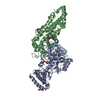



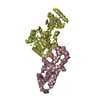

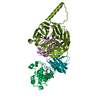

 PDBj
PDBj